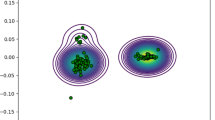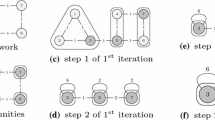Abstract
Since various complex systems are represented by networks, detecting and tracking local communities has become a crucial task nowadays. Local community detection methods are getting much attention because they can address large networks. One famous class of local community detection is to find communities around a seed node. In this research, a novel local community detection method, inspired by geometric active contours, is proposed for finding a community surrounding an initial seed. While most of real world networks are dynamic and the majority of local community detection cannot tackle dynamic networks, the proposed model has the ability to track a local community in a dynamic network. The proposed model introduces and uses the derivative-based concepts curvature and gradient of the boundary of a connected sub-graph in networks. Then, a velocity function based on curvature and gradient is proposed to determine if the boundary of a community should evolve to include a neighbouring candidate. Approximating derivatives in discrete Euclidean space has a long history. However, compared to Euclidean space, graphs follow a non-uniform space in which the dimensionality, given by the the fluctuation in degrees of nodes, fluctuates from one node to another. This complexity complicates the approximation of derivatives which are needed for defining the curvature and gradient of a node in the boundary of a community. A new framework to approximate derivatives in graphs is proposed for such a purpose. For finding local communities, benchmarking our method against two recent methods indicates that it is capable of finding communities with equal or better conductance; and, for tracking dynamic local communities, benchmarking of the proposed method against ground-truth dataset shows a noticeable level of accuracy.



















Similar content being viewed by others
References
Ahn, Y-Y, Bagrow, J.P., Lehmann, S.: Link communities reveal multiscale complexity in networks. Nature 466(7307), 761–764 (2010)
Andersen, R., Lang, K.J.: Communities from seed sets. In: Proceedings of the 15th international conference on World Wide Web, pp 223–232. ACM (2006)
Bagrow, J.P., Bollt, E.M.: Local method for detecting communities. Phys. Rev. E 72(4), 046108 (2005)
Bansal, N., Blum, A., Chawla, S.: Correlation clustering. Mach. Learn. 56 (1-3), 89–113 (2004)
Brandes, U., Delling, D., Gaertler, M., Görke, R, Hoefer, M., Nikoloski, Z., Wagner, D.: On modularity-np-completeness and beyond. Citeseer (2006)
Canu, M., Lesot, M-J, d’Allonnes, A.R.: Vertex-centred method to detect communities in evolving networks. In: International workshop on complex networks and their applications, pp 275–286. Springer (2016)
Caselles, V., Kimmel, R., Sapiro, G.: Geodesic active contours. Int. J. Comput. Vis. 22(1), 61–79 (1997)
Chan, T.F., Vese, L., et al.: Active contours without edges. IEEE Trans. Image. Process. 10(2), 266–277 (2001)
Charikar, M., Guruswami, V., Wirth, A.: Clustering with qualitative information. In: 44th Annual IEEE symposium on foundations of computer science, 2003. Proceedings, pp 524–533. IEEE (2003)
Chen, J., Yuan, B.: Detecting functional modules in the yeast protein–protein interaction network. Bioinformatics 22(18), 2283–2290 (2006)
Chen, J., Zaiane, O.R., Goebel, R.: Detecting communities in large networks by iterative local expansion. In: International conference on computational aspects of social networks, 2009. CASON’09, pp 105–112. IEEE (2009)
Clauset, A.: Finding local community structure in networks. Phys. Rev. E 72 (2), 026132 (2005)
Clauset, A., Newman, M.E., Moore, C.: Finding community structure in very large networks. Phys. Rev. E 70(6), 066111 (2004)
Coleman, J.S., et al.: Introduction to mathematical sociology. London Free Press, Glencoe (1964)
Courant, R., Friedrichs, K., Lewy, H.: Über die partiellen differenzengleichungen der mathematischen physik. Math. Ann. 100(1), 32–74 (1928)
Danon, L., Diaz-Guilera, A., Duch, J., Arenas, A.: Comparing community structure identification. J. Stat. Mech:. Theory. Exper. 2005(09), P09008 (2005)
Diao, P., Guillot, D., Khare, A., Rajaratnam, B.: Differential calculus on graphon space. J. Comb. Theory. Series. A 133, 183–227 (2015)
Du, H., Feldman, M.W., Li, S., Jin, X.: An algorithm for detecting community structure of social networks based on prior knowledge and modularity. Complexity 12 (3), 53–60 (2007)
Falkowski, T.: Community analysis in dynamic social networks. Sierke (2009)
Farhangi, M.M., Frigui, H., Bert, R., Amini, A.A.: Incorporating shape prior into active contours with a sparse linear combination of training shapes: application to corpus callosum segmentation. In: 2016 IEEE 38th Annual international conference of the engineering in medicine and biology society (EMBC), pp 6449–6452. IEEE (2016)
Farhangi, M.M., Frigui, H., Seow, A., Amini, A.A.: 3-d active contour segmentation based on sparse linear combination of training shapes (scots). IEEE Trans. Med. Imaging. 36(11), 2239–2249 (2017)
Fortunato, S.: Community detection in graphs. Phys. Rep. 486(3), 75–174 (2010)
Friedman, J., Tillich, J-P: Calculus on graphs. arXiv preprint cs/0408028 (2004)
Golub, G.H., Van Loan, C.F.: Matrix computations, vol 3. JHU Press (2012)
Görke, R, Kluge, R., Schumm, A., Staudt, C., Wagner, D.: An efficient generator for clustered dynamic random networks. In: Design and analysis of algorithms - first mediterranean conference on algorithms, MedAlg 2012, Kibbutz Ein Gedi, Israel, December 3-5, 2012. Proceedings, volume 7659 of lecture notes in computer science (LNCS), pp 219–233. Springer International Publishing, Switzerland (2012)
Hu, Y., Yang, B., Lv, C.: A local dynamic method for tracking communities and their evolution in dynamic networks. Knowl-Based. Syst. 110, 176–190 (2016)
Jeub, L.G., Balachandran, P., Porter, M.A., Mucha, P.J., Mahoney, M.W.: Think locally, act locally: detection of small, medium-sized, and large communities in large networks. Phys. Rev. E 91(1), 012821 (2015)
Johnson, S.C.: Hierarchical clustering schemes. Psychometrika 32(3), 241–254 (1967)
Khorasgani, R.R., Chen, J., Zaiane, O.R.: Top leaders community detection approach in information networks. In: 4th SNA-KDD workshop on social network mining and analysis (2010)
Kleinberg, J.M.: Authoritative sources in a hyperlinked environment. J. ACM 46(5), 604–632 (1999)
Kottak CP: Cultural anthropology: appreciating cultural diversity. McGraw-Hill (2011)
Krishnamurthy, B., Wang, J.: On network-aware clustering of Web clients. ACM SIGCOMM. Comput. Commun. Rev. 30(4), 97–110 (2000)
Lancichinetti, A., Fortunato, S.: Community detection algorithms: a comparative analysis. Phys. Rev. E 80(5), 056117 (2009)
Lancichinetti, A., Fortunato, S., Kertész, J: Detecting the overlapping and hierarchical community structure in complex networks. J. Phys. 11(3), 033015 (2009)
Lawson, C.L., Hanson, R.J.: Solving least squares problems, vol 15. SIAM (1995)
Leskovec, J., Kleinberg, J., Faloutsos, C.: Graphs over time: densification laws, shrinking diameters and possible explanations. In: Proceedings of the eleventh ACM SIGKDD international conference on Knowledge discovery in data mining, pp 177–187. ACM (2005)
Leskovec, J., Lang, K.J., Dasgupta, A., Mahoney, M.W.: Community structure in large networks: natural cluster sizes and the absence of large well-defined clusters. Internet. Math. 6(1), 29–123 (2009)
Leskovec, J., Lang, K.J., Mahoney, M.: Empirical comparison of algorithms for network community detection. In: Proceedings of the 19th international conference on World wide Web, pp 631–640. ACM (2010)
Mahoney, M.W., Orecchia, L., Vishnoi, N.K.: A local spectral method for graphs: with applications to improving graph partitions and exploring data graphs locally. J. Mach. Learn. Res. 13(1), 2339–2365 (2012)
Mcauley, J., Leskovec, J.: Discovering social circles in ego networks. ACM Trans. Knowl. Discov. Data. (TKDD) 8(1), 4 (2014)
Ng, A.Y., Jordan, M.I., Weiss, Y., et al.: On spectral clustering: analysis and an algorithm. Adv. Neural. Inf. Process. Syst. 2, 849–856 (2002)
Nguyen, N.P., Dinh, T.N., Tokala, S., Thai, M.T.: Overlapping communities in dynamic networks: their detection and mobile applications. In: Proceedings of the 17th annual international conference on mobile computing and networking, pp 85–96. ACM (2011)
Palla, G., Derényi, I, Farkas, I., Vicsek, T.: Uncovering the overlapping community structure of complex networks in nature and society. Nature 435(7043), 814–818 (2005)
Radicchi, F., Castellano, C., Cecconi, F., Loreto, V., Parisi, D.: Defining and identifying communities in networks. Proc. Natl. Acad. Sci. USA 101(9), 2658–2663 (2004)
Rand, W.M.: Objective criteria for the evaluation of clustering methods. J. Am. Stat. Assoc. 66(336), 846–850 (1971)
Rives, A.W., Galitski, T.: Modular organization of cellular networks. Proc. Natl. Acad. Sci. 100(3), 1128–1133 (2003)
Rigi, M.A., Moser, I., Rigi, S., Liu, C.: Re-imaginig the networks: detecting local communities in networks by approximating derivatives in graph space. In: Proceedings of the 2017 IEEE/ACM international conference on advances in social networks analysis and mining 2017, ASONAM ’17, pp 974–981. ACM, New York (2017)
Samie, M.E., Hamzeh, A.: Community detection in dynamic social networks: a local evolutionary approach. J Inf Sci, 0165551516657717 (2016)
Schaeffer, S.E.: Graph clustering. Comput. Sci. Rev. 1(1), 27–64 (2007)
Serrano, M., Boguñá, M, Pastor-Satorras, R., Vespignani, A.: Large scale structure and dynamics of complex networks: from information technology to finance and natural sciences (2007)
Shang, J., Liu, L., Li, X., Xie, F., Wu, C.: Targeted revision: a learning-based approach for incremental community detection in dynamic networks. Physica. A:. Stat. Mech. Appl. 443(Supplement C), 70–85 (2016)
Solomon, J.: Pde approaches to graph analysis. arXiv:1505.00185 (2015)
Spiliopoulou, M., Ntoutsi, I., Theodoridis, Y., Schult, R.: Monic: modeling and monitoring cluster transitions. In: Proceedings of the 12th ACM SIGKDD international conference on knowledge discovery and data mining, pp 706–711. ACM (2006)
Sun, J., Faloutsos, C., Papadimitriou, S., Yu, P.S.: Graphscope: parameter-free mining of large time-evolving graphs. In: Proceedings of the 13th ACM SIGKDD international conference on knowledge discovery and data mining, pp 687–696. ACM (2007)
Takaffoli, M., Fagnan, J., Sangi, F., Zaïane, OR: Tracking changes in dynamic information networks. In: 2011 International conference on computational aspects of social networks (CASoN), pp 94–101. IEEE (2011)
Takaffoli, M., Rabbany, R., Zaïane, OR: Incremental local community identification in dynamic social networks. In: Proceedings of the 2013 IEEE/ACM international conference on advances in social networks analysis and mining, pp 90–94. ACM (2013)
Tong, H., Papadimitriou, S., Sun, J., Yu, P.S., Faloutsos, C.: Colibri: fast mining of large static and dynamic graphs. In: Proceedings of the 14th ACM SIGKDD international conference on knowledge discovery and data mining, pp 686–694. ACM (2008)
Toyoda, M., Kitsuregawa, M.: Creating a Web community chart for navigating related communities. In: Proceedings of the 12th ACM conference on hypertext and hypermedia, HYPERTEXT ’01, pp 103–112. ACM, New York (2001)
Traud, A.L., Mucha, P.J., Porter, M.A.: Social structure of facebook networks. Physica. A:. Stat. Mech. Appl. 391(16), 4165–4180 (2012)
Xu, T., Zhang, Z., Yu, P.S., Long, B.: Generative models for evolutionary clustering. ACM Trans. Knowl. Discov. Data. (TKDD) 6(2), 7 (2012)
Yang, T., Chi, Y., Zhu, S., Gong, Y., Jin, R.: Detecting communities and their evolutions in dynamic social networks—a bayesian approach. Mach. Learn. 82(2), 157–189 (2011)
Yoshida, T.: Toward finding hidden communities based on user profile. J. Intell. Inf. Syst. 40(2), 189–209 (2013)
Author information
Authors and Affiliations
Corresponding author
Additional information
Publisher’s note
Springer Nature remains neutral with regard to jurisdictional claims in published maps and institutional affiliations.
Appendices
Appendix A: Error analysis
Suppose F and G are two functions defined with \(F^{\prime }(v_{c})\) and \(G^{\prime }(v_{c})\) as the first order derivative in node C. Then:
Proof: Suppose D is the derivative matrix in (30). We define \(D_{1}^{(-1)}\) as the first row of matrix D(− 1), and H = F + G:
Differentation rule’s proof is similar to addition.
Multiplication rule: We define H = F.G where . is the inner product operator.
Division rule:
Depending on the neighbors of node C, the term G(v), appeared in the right hand side of multiplication and division rules, can be approximated differently. For a simple case where node C is connected to just one node V, multiplication is rewritten:
and division rule is simplified:
Appendix B: List of symbols
- C:
-
community
- t:
-
time step
- ∇:
-
differential operator
- κ:
-
curvature
- ∂:
-
partial derivative
- n :
-
normal direction
- V:
-
set of graph nodes
- G:
-
graph
- χ:
-
graph shape
- E:
-
set of graph nodes
- ν:
-
set of shape nodes
- ξ:
-
set of shape edges
- O:
-
truncation error
- F:
-
similarity function
- d:
-
node difference
- e:
-
approximation error
- N:
-
set of a node’s neighbours
- s:
-
velocity
Rights and permissions
About this article
Cite this article
Rigi, M.A., Moser, I., Farhangi, M.M. et al. Finding and tracking local communities by approximating derivatives in networks. World Wide Web 23, 1519–1551 (2020). https://doi.org/10.1007/s11280-019-00737-2
Received:
Revised:
Accepted:
Published:
Issue Date:
DOI: https://doi.org/10.1007/s11280-019-00737-2




